SNOS965J June 2001 – December 2015 LM2611
PRODUCTION DATA.
- 1 Features
- 2 Applications
- 3 Description
- 4 Revision History
- 5 Pin Configuration and Functions
- 6 Specifications
- 7 Detailed Description
-
8 Application and Implementation
- 8.1 Application Information
- 8.2 Typical Application
- 9 Power Supply Recommendations
- 10Layout
- 11Device and Documentation Support
- 12Mechanical, Packaging, and Orderable Information
Package Options
Mechanical Data (Package|Pins)
- DBV|5
Thermal pad, mechanical data (Package|Pins)
Orderable Information
6 Specifications
6.1 Absolute Maximum Ratings
over operating free-air temperature range (unless otherwise noted)(1)| MIN | MAX | UNIT | |
|---|---|---|---|
| Input voltage, VIN | 14.5 | V | |
| SW voltage | –0.4 | 36 | V |
| NFB voltage | –6 | 0.4 | V |
| SHDN voltage | –0.4 | 14.5 | V |
| Maximum junction temperature | 125 | °C | |
| Power dissipation (2) | Internally limited | ||
| Lead temperature | 300 | °C | |
| Storage temperature, Tstg | −65 | 150 | °C |
(1) Stresses beyond those listed under Absolute Maximum Ratings may cause permanent damage to the device. These are stress ratings only, which do not imply functional operation of the device at these or any other conditions beyond those indicated under Recommended Operating Conditions. Exposure to absolute-maximum-rated conditions for extended periods may affect device reliability.
(2) The maximum allowable power dissipation is a function of the maximum junction temperature, TJ(MAX), the junction-to-ambient thermal resistance, θJA, and the ambient temperature, TA. See the Electrical Characteristics table for the thermal resistance of various layouts. The maximum allowable power dissipation at any ambient temperature is calculated using: PD (MAX) = (TJ(MAX) − TA)/θJA. Exceeding the maximum allowable power dissipation will cause excessive die temperature, and the regulator will go into thermal shutdown.
6.2 ESD Ratings
| VALUE | UNIT | |||
|---|---|---|---|---|
| V(ESD) | Electrostatic discharge | Human-body model (HBM), per ANSI/ESDA/JEDEC JS-001(1)(2) | ±2000 | V |
| Machine Model (MM)(3) | ±200 | |||
(1) JEDEC document JEP155 states that 500-V HBM allows safe manufacturing with a standard ESD control process.
(2) The human body model is a 100-pF capacitor discharged through a 1.5-kΩ resistor into each pin.
(3) The machine model is a 200-pF capacitor discharged directly into each pin.
6.3 Recommended Operating Conditions
| MIN | NOM | MAX | UNIT | |
|---|---|---|---|---|
| Supply voltage | 2.7 | 14 | V | |
| Operating junction temperature, TJ | −40 | 125 | °C |
6.4 Thermal Information
| THERMAL METRIC(1) | LM2611 | UNIT | |
|---|---|---|---|
| DBV (SOT-23) | |||
| 5 PINS | |||
| RθJA | Junction-to-ambient thermal resistance | 163.5 | °C/W |
| RθJC(top) | Junction-to-case (top) thermal resistance | 115.2 | °C/W |
| RθJB | Junction-to-board thermal resistance | 27.4 | °C/W |
| ψJT | Junction-to-top characterization parameter | 12.9 | °C/W |
| ψJB | Junction-to-board characterization parameter | 26.9 | °C/W |
| RθJC(bot) | Junction-to-case (bottom) thermal resistance | n/a | °C/W |
(1) For more information about traditional and new thermal metrics, see the Semiconductor and IC Package Thermal Metrics application report, SPRA953.
6.5 Electrical Characteristics
Specifications in standard type face are for TJ = 25°C, unless otherwise specified. VIN = 5 V and IL = 0 A, unless otherwise specified.| PARAMETER | TEST CONDITIONS | MIN (1) | TYP (2) | MAX (1) | UNIT | |
|---|---|---|---|---|---|---|
| VIN | Input voltage | TJ = −40°C to +85°C | 2.7 | 14 | V | |
| ISW | Switch current limit | Grade A | 1.2 | A | ||
| Grade A; TJ = −40°C to +85°C | 1 | 2 | ||||
| Grade B | 0.9 | |||||
| Grade B; TJ = −40°C to +85°C | 0.7 | |||||
| RDSON | Switch ON resistance | Grade A | 0.5 | 0.65 | Ω | |
| Grade B | 0.7 | 0.9 | ||||
| SHDNTH | Shutdown threshold | Device enabled; TJ = −40°C to +85°C | 1.5 | V | ||
| Device disabled; TJ = −40°C to +85°C | 0.5 | |||||
| ISHDN | Shutdown pin bias current | VSHDN = 0 V | 0 | µA | ||
| VSHDN = 5 V | 0 | |||||
| VSHDN = 5 V; TJ = −40°C to +85°C | 1 | |||||
| NFB | Negative feedback reference | VIN = 3 V | −1.23 | V | ||
| VIN = 3 V; TJ = −40°C to +85°C | −1.205 | −1.255 | ||||
| INFB | NFB pin bias current | VNFB =−1.23 V | −4.7 | µA | ||
| VNFB =−1.23 V; TJ = −40°C to +85°C | −2.7 | −6.7 | ||||
| Iq | Quiescent current | VSHDN = 5 V, Switching | 1.8 | mA | ||
| VSHDN = 5 V, Switching; TJ = −40°C to +85°C |
3.5 | |||||
| VSHDN = 5 V, Not Switching | 270 | µA | ||||
| VSHDN = 5 V, Not Switching; TJ = −40°C to +85°C |
500 | |||||
| VSHDN = 0 V | 0.024 | µA | ||||
| VSHDN = 0 V; TJ = −40°C to +85°C | 1 | |||||
| %VOUT/ ΔVIN | Reference line regulation | 2.7 V ≤ VIN ≤ 14 V | 0.02 | %/V | ||
| fS | Switching frequency | TJ = 25°C | 1.4 | MHz | ||
| TJ = −40°C to +85°C | 1 | 1.8 | ||||
| DMAX | Maximum duty cycle | TJ = 25°C | 88% | |||
| TJ = −40°C to +85°C | 82% | |||||
| IL | Switch leakage | VSW = 5 V, Not Switching | 1 | µA | ||
(1) All limits are specified at room temperature (standard typeface) and at temperature extremes (bold typeface). All room temperature limits are 100% tested through statistical analysis. All limits at temperature extremes via correlation using standard Statistical Quality Control (SQC) methods. All limits are used to calculate Average Outgoing Quality Level (AOQL).
(2) Typical numbers are at 25°C and represent the expected value of the parameter.
Typical Characteristics
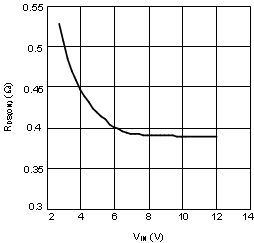
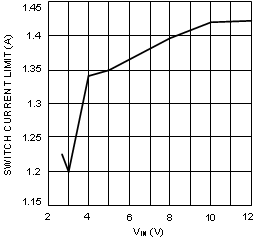
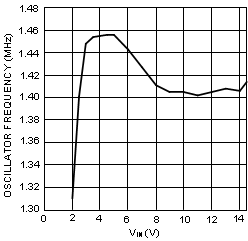
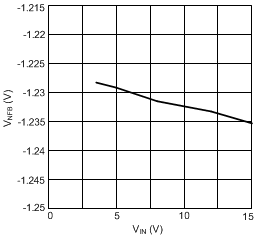
| TA = 25°C | VOUT = −5 V |
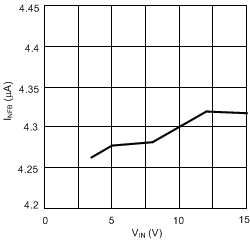
| TA = 25°C | VOUT = −5 V |
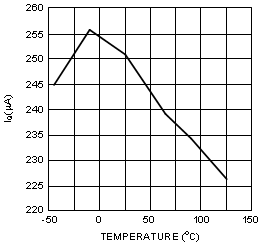
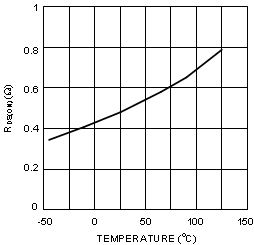
| VIN = 5 V |
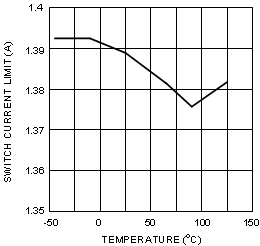
| VIN = 5 V |
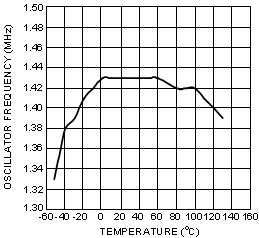
| VIN = 5 V |
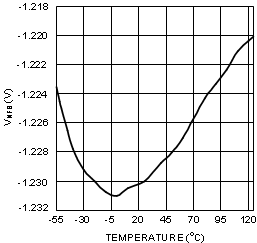
| VIN = 5 V |
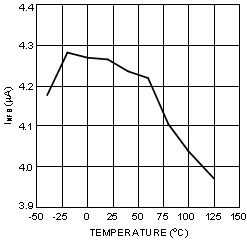
| VIN = 3.5 V | VOUT = −5 V |
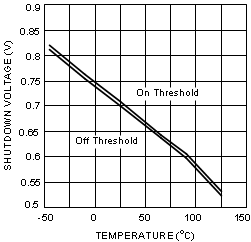
| VIN = 5 V |